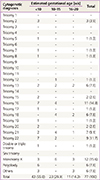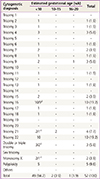1. Speroff L, Glass RH, Kase NG. Clinical gynecologic endocrinology and infertility. 6th ed. Philadelphia: Lippincott Williams & Wilkins;1999.
2. Zinaman MJ, Clegg ED, Brown CC, O'Connor J, Selevan SG. Estimates of human fertility and pregnancy loss. Fertil Steril. 1996; 65:503–509.
3. Rai R, Regan L. Recurrent miscarriage. Lancet. 2006; 368:601–611.
4. Stephenson M, Kutteh W. Evaluation and management of recurrent early pregnancy loss. Clin Obstet Gynecol. 2007; 50:132–145.
5. Hassold TJ. A cytogenetic study of repeated spontaneous abortions. Am J Hum Genet. 1980; 32:723–730.
6. Stirrat GM. Recurrent miscarriage. Lancet. 1990; 336:673–675.
7. Hogge WA, Byrnes AL, Lanasa MC, Surti U. The clinical use of karyotyping spontaneous abortions. Am J Obstet Gynecol. 2003; 189:397–400.
8. Stephenson MD, Awartani KA, Robinson WP. Cytogenetic analysis of miscarriages from couples with recurrent miscarriage: a case-control study. Hum Reprod. 2002; 17:446–451.
9. Kalousek DK, Pantzar T, Tsai M, Paradice B. Early spontaneous abortion: morphologic and karyotypic findings in 3,912 cases. Birth Defects Orig Artic Ser. 1993; 29:53–61.
10. Fritz B, Hallermann C, Olert J, Fuchs B, Bruns M, Aslan M, et al. Cytogenetic analyses of culture failures by comparative genomic hybridisation (CGH)-Re-evaluation of chromosome aberration rates in early spontaneous abortions. Eur J Hum Genet. 2001; 9:539–547.
11. Abdalla HI, Burton G, Kirkland A, Johnson MR, Leonard T, Brooks AA, et al. Age, pregnancy and miscarriage: uterine versus ovarian factors. Hum Reprod. 1993; 8:1512–1517.
12. Munne S, Alikani M, Tomkin G, Grifo J, Cohen J. Embryo morphology, developmental rates, and maternal age are correlated with chromosome abnormalities. Fertil Steril. 1995; 64:382–391.
13. Nybo Andersen AM, Wohlfahrt J, Christens P, Olsen J, Melbye M. Maternal age and fetal loss: population based register linkage study. BMJ. 2000; 320:1708–1712.
14. Poland BJ, Miller JR, Jones DC, Trimble BK. Reproductive counseling in patients who have had a spontaneous abortion. Am J Obstet Gynecol. 1977; 127:685–691.
15. Regan L, Braude PR, Trembath PL. Influence of past reproductive performance on risk of spontaneous abortion. BMJ. 1989; 299:541–545.
16. Rubio C, Pehlivan T, Rodrigo L, Simon C, Remohi J, Pellicer A. Embryo aneuploidy screening for unexplained recurrent miscarriage: a minireview. Am J Reprod Immunol. 2005; 53:159–165.
17. Carp H, Toder V, Aviram A, Daniely M, Mashiach S, Barkai G. Karyotype of the abortus in recurrent miscarriage. Fertil Steril. 2001; 75:678–682.
18. Ogasawara M, Aoki K, Okada S, Suzumori K. Embryonic karyotype of abortuses in relation to the number of previous miscarriages. Fertil Steril. 2000; 73:300–304.
19. Stern JJ, Dorfmann AD, Gutierrez-Najar AJ, Cerrillo M, Coulam CB. Frequency of abnormal karyotypes among abortuses from women with and without a history of recurrent spontaneous abortion. Fertil Steril. 1996; 65:250–253.
20. Sullivan AE, Silver RM, LaCoursiere DY, Porter TF, Branch DW. Recurrent fetal aneuploidy and recurrent miscarriage. Obstet Gynecol. 2004; 104:784–788.
21. Li TC, Makris M, Tomsu M, Tuckerman E, Laird S. Recurrent miscarriage: aetiology, management and prognosis. Hum Reprod Update. 2002; 8:463–481.
22. Ohno M, Maeda T, Matsunobu A. A cytogenetic study of spontaneous abortions with direct analysis of chorionic villi. Obstet Gynecol. 1991; 77:394–398.
23. Simpson JL. Incidence and timing of pregnancy losses: relevance to evaluating safety of early prenatal diagnosis. Am J Med Genet. 1990; 35:165–173.
24. Nicolaidis P, Petersen MB. Origin and mechanisms of non-disjunction in human autosomal trisomies. Hum Reprod. 1998; 13:313–319.
25. Bajnoczky K, Gardo S. "Premature anaphase" in a couple with recurrent miscarriages. Hum Genet. 1993; 92:388–390.
26. Simpson JL. Causes of fetal wastage. Clin Obstet Gynecol. 2007; 50:10–30.
27. Bui TH, Vetro A, Zuffardi O, Shaffer LG. Current controversies in prenatal diagnosis 3: is conventional chromosome analysis necessary in the post-array CGH era? Prenat Diagn. 2011; 31:235–243.
28. Carp H, Guetta E, Dorf H, Soriano D, Barkai G, Schiff E. Embryonic karyotype in recurrent miscarriage with parental karyotypic aberrations. Fertil Steril. 2006; 85:446–450.
29. Stephenson MD, Sierra S. Reproductive outcomes in recurrent pregnancy loss associated with a parental carrier of a structural chromosome rearrangement. Hum Reprod. 2006; 21:1076–1082.
30. Clifford K, Rai R, Watson H, Regan L. An informative protocol for the investigation of recurrent miscarriage: preliminary experience of 500 consecutive cases. Hum Reprod. 1994; 9:1328–1332.
31. Franssen MT, Korevaar JC, Leschot NJ, Bossuyt PM, Knegt AC, Gerssen-Schoorl KB, et al. Selective chromosome analysis in couples with two or more miscarriages: case-control study. BMJ. 2005; 331:137–141.







 PDF
PDF ePub
ePub Citation
Citation Print
Print





 XML Download
XML Download